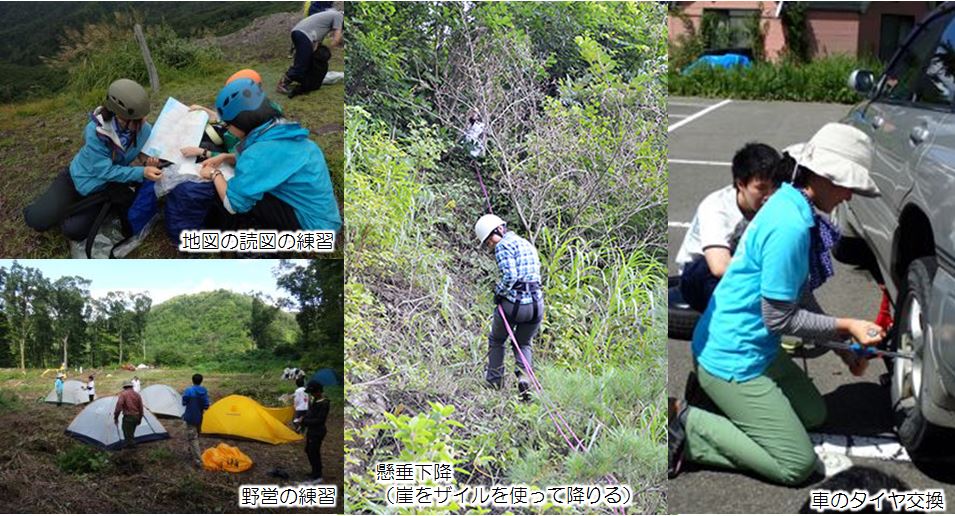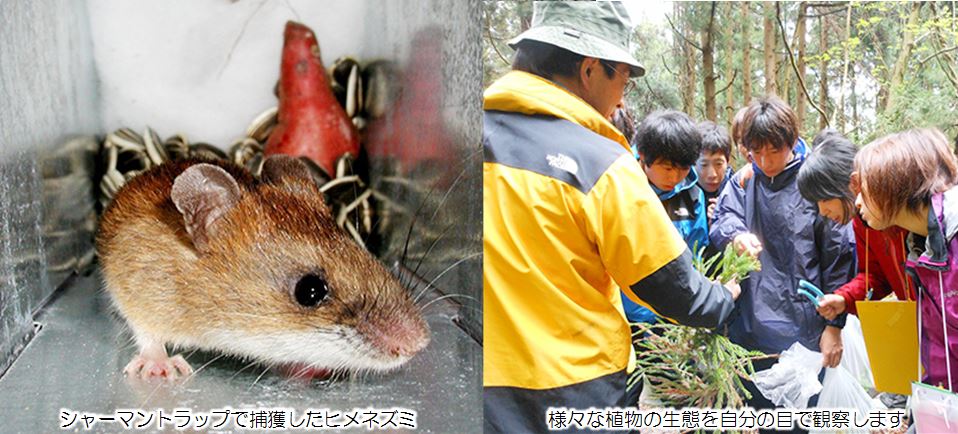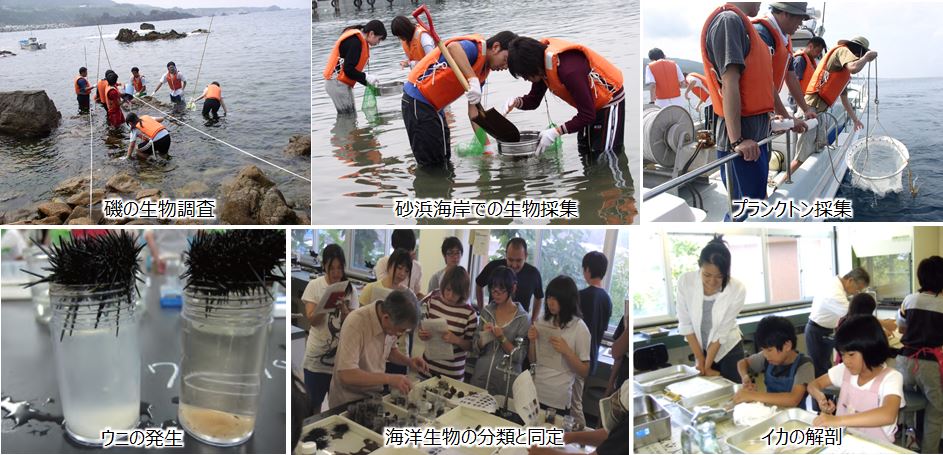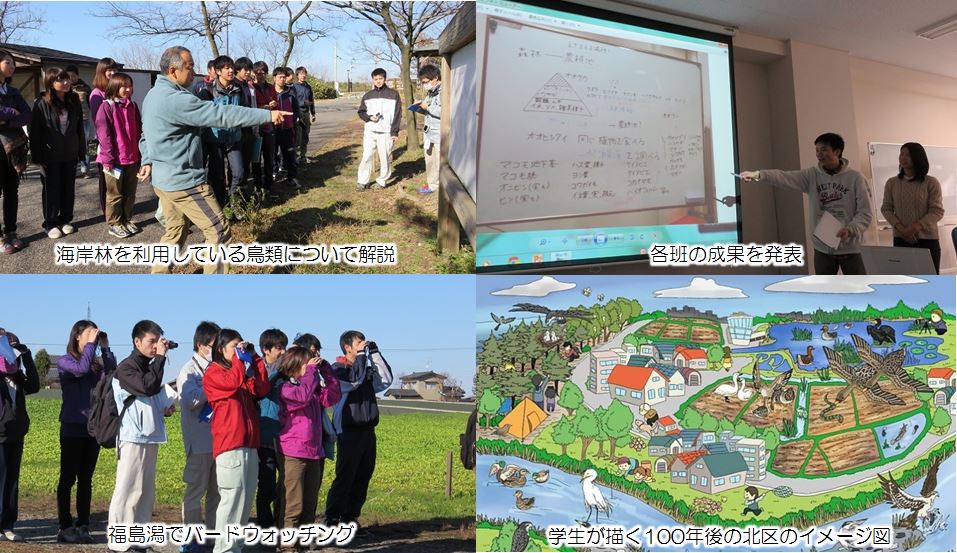Marine chemistry
The ocean is an earth system that is deeply connected to important issues facing humanity, such as the conservation of ecosystems and marine resources, marine pollution, acidification, and climate change. In this class, you will learn how the ocean works and how to understand it using a chemical approach. Specifically, based on the fundamentals of oceanographic parameters, biological oceanography, and physical oceanography, which are essential for field observation of the ocean, we will study the mechanisms governing the distribution of chemical substances, the role of chemical components in ecosystems and carbon cycles, and learn how to analyze ocean material circulation.
Ecology
Living things do not live alone, but form ecosystems through interactions with the surrounding physical and chemical environment and other living things. In this lecture, you will learn about the influence of the surrounding environment on the evolution of living things and the density of living organisms' populations, and further learn that interactions with the environment change over time and space, creating biodiversity.
Geological disaster theory
In recent years, abnormal weather, large earthquakes, and volcanic eruptions have occurred frequently on a global scale, and along with this, geological disasters such as slope disasters, earthquake disasters, and volcanic disasters have also occurred frequently. Such disasters have repeatedly occurred during the Quaternary era, when humans were born and the current topography and geology were created. In the lecture, we will also explain geological disasters, their causes, and the Quaternary crustal deformation that is the background to them, and think about the future of the global environment.
Environmental physics
In the natural environment surrounding us, energy and materials are constantly transported and exchanged. Quantitatively quantify the transport and exchange processes of energy and materials between the atmosphere, land surface, water surface, and ecosystems near the earth's surface using physical quantities (temperature, humidity, wind speed, solar radiation, etc.) based on the laws of physics. Learn how to evaluate and understand the mechanisms of natural environmental systems, including ecosystems.
Weather analysis training, terrain analysis training
In the weather analysis training, you will learn how to analyze weather data using the Fortran programming language, how to create weather maps, how to read high-rise weather maps, and forecast weather. In the terrain analysis training, students will learn how to use geographic information systems (GIS), the basics of satellite data, and methods for analyzing terrain changes using GIS and terrain data (topographic maps and satellite data).
Seaside training I
The ocean is inhabited by organisms from all animal phyla, with a wide variety of systems ranging from simple to complex and elaborate. In this practical training, you will learn basic ecological survey methods in various aquatic fields from the coast of Sado Island to estuaries and rivers. Collect the diverse marine organisms that live there, learn about their body structure, development, physiological functions, behavior, and ecology, and understand the forms, functions, and ecological diversity of marine organisms and their evolution.
Environmental erosion control
Japan's mountains are not only steep but also geologically fragile, so when heavy rain falls during the rainy season or typhoons, there is a risk of mountainside collapse and debris flows, causing serious damage. For this reason, erosion control projects have been developed to prevent disasters by preventing collapses as much as possible, and in the event of collapses, controlling the movement of sediment. In this class, you will learn about the ideal form of erosion control work that takes into consideration not only disaster prevention but also the preservation of the natural environment and mountain stream ecosystem.
Forest environment
Forests are made up of living organisms such as plants, animals, and microorganisms, and the inorganic environment that surrounds them such as soil, water, and air, and an ecosystem is formed by maintaining close relationships with each other through the circulation of materials and energy. . In this lecture, we will explain the classification and properties of forest soil, the relationship between plants and soil (including the growth and location conditions of planted trees), the water environment of forests, and material production and material cycles in forests.
Global warming mechanism/effects
Learn about the mechanism of global warming and the effects of global warming on living things and ecosystems. The main content of the second half is environmental change on a geohistorical scale, the impact of global warming on the forests and creatures of the world and Japan (Niigata), and our lives, measures to adapt to global warming, and IPCC No. 5. Regarding the next evaluation report, etc.
Wild fauna and flora ecology training
This subject will be taught by multiple teachers. We conduct field surveys on changes in vegetation due to differences in climate conditions (altitude) and location conditions (topography), and conduct analyzes and considerations based on these data.
Wildlife ecology
In Japan, the northern red-eared flycatcher, wolf, and Japanese ibis have become extinct, and there are concerns that large mammals and birds such as the Asian black bear and golden eagle may become extinct. On the other hand, it has been pointed out that damage caused by wild animals to agriculture and forestry is expanding, and that alien species such as black bass and raccoons have become naturalized and established, which is having an extremely serious impact on Japan's ecosystem. In this course, we will use evolutionary biology and animal ecology to study the processes by which living organisms have evolved into their current forms and the mechanisms by which the ecosystems made up of these living organisms are made up. I will outline from the perspective.
Ecosystem management exercises and practical training
Under the National Biodiversity Strategy, land use in Japan is strongly required to introduce ecosystem management that takes biodiversity conservation into consideration as much as possible. What is important in advancing this process is being able to understand the mechanisms of ecosystems in an integrated manner, and based on that knowledge, being able to propose management and restoration methods necessary for ecosystems to function sustainably. This exercise adopts a PBL class format, and by making use of the knowledge and techniques related to ecology and metrology acquired through lectures and practical training, group Through this work, you will develop the ability to create and propose appropriate management measures from the perspective of ecosystem conservation.
Wild plant ecology
We will provide an overview of the life strategies of wild plants and systematically explain the relationship between plants and the external environment, especially from a physiological and ecological perspective. Next, we will explain the relationship between the structure of plant populations/communities and their physiological characteristics.
Geological field training
Volcanoes, which exist not only in Japan but all over the world and throughout the solar system, including Mars and the Moon, attract a lot of attention not only from a scientific perspective, but also from a tourism resource and disaster perspective. By actually visiting areas that were formed by volcanic eruptions and witnessing the geology, topography, environment, and history, you can learn about the above points in a more realistic way. Therefore, in this subject, we will focus on Mt. Asama and provide on-site lessons at an active volcano as well as basic geological survey experience.
The course list is available from below link:
https://www.sc.niigata-u.ac.jp/sc/edu/subject/index.html#subject-fresTraining classes
Risk management training for field workers
Accurately acquire the skills necessary to carry out field work safely and reliably, such as how to read the weather, how to read maps, first aid methods, tree climbing methods, outdoor camping methods, and rope work. Students will acquire risk management skills that will enable them to safely carry out even difficult field investigations on their own.

Wild fauna and flora ecology training
The goal is to gain an experiential understanding of the ecological characteristics of wild animals and plants, as well as acquire basic techniques for managing organisms that take these into account. Basic vegetation survey methods, observation of the horizontal and vertical structure of forests and their relationship with the light environment, plant physiology (photosynthesis, respiration, resource distribution), sexual expression and pollination of plants, wild animals in rice paddies and satoyama. Insect research methods, bird research methods

Seaside training I
Learn basic ecological survey methods in various aquatic fields from the coast of Sado Island to estuaries and rivers. Collect the diverse marine organisms that live there, learn about their body structure, development, physiological functions, behavior, and ecology, and understand the forms, functions, and ecological diversity of marine organisms and their evolution.

Ecosystem management exercises and training
By utilizing the knowledge and techniques related to ecology and metrology acquired through lectures and practical training, we will be able to develop appropriate management measures from the perspective of ecosystem conservation through group work targeting three different environments: farmland, forest, and riverside. We will develop the ability to create and propose ideas.

Geological field training, topographical field training
Students learn practical geological and topographical survey methods through on-site observation and experience in and outside of Niigata Prefecture.

Disaster prevention exercises and training
We conduct field surveys at sites where landslides have occurred, and based on the results, design the necessary erosion control facilities to prevent secondary disasters. Through this, students will learn the investigation and design techniques necessary for disaster prevention engineers.

